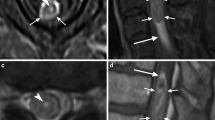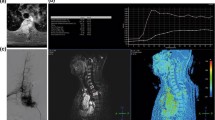Abstract
Introduction
The purpose of this study was to determine the added value of the perimedullary spinal vein enlargement sign on magnetic resonance imaging (MRI) in distinguishing intradural-extramedullary tumors (IDEMTs) from intramedullary spinal tumors (IMTs).
Methods
Two hundred and eight consecutive spinal intradural tumors with histopathologic confirmation (21 IMTs, 187 IDEMTs) were enrolled. Two readers blinded to the final pathological diagnosis and clinical data independently assessed the venous enlargement sign to determine the agreement between them and jointly distinguished IDEMTs from IMTs according to the common MRI findings. Sensitivity, specificity, and accuracy for the diagnosis of IDEMTs were calculated for the common MRI findings, vein enlargement sign, and a combination of both.
Results
Intraobserver agreement and interobserver agreement for both readers was excellent. The sensitivity, specificity, and accuracy of common MRI findings for differentiating IDEMTs from IMTs were 83.4, 95.2, and 89.3 %, respectively. Thirty-one IDEMTs were mistakenly diagnosed as IMTs, in which seven were cases with vein enlargement signs. By applying the vein enlargement sign to the common MRI findings, the specificity remained at 95.2 %, while the sensitivity improved to 89.3 % and the accuracy increased to 92.3 %.
Conclusion
The spinal perimedullary vein enlargement sign is useful in assessing intradural tumors and to differentiate IDEMTs from IMTs.







Similar content being viewed by others
References
Baleriaux DL (1999) Spinal cord tumors. Eur Radiol 9(7):1252–1258. doi:10.1007/s003300050831
Sciubba DM, Petteys RJ, Dekutoski MB, Fisher CG, Fehlings MG, Ondra SL, Rhines LD, Gokaslan ZL (2010) Diagnosis and management of metastatic spine disease. A review. J Neurosurg Spine 13(1):94–108. doi:10.3171/2010.3.SPINE09202
Quraishi NA, Esler C (2011) Metastatic spinal cord compression. BMJ 342:d2402. doi:10.1136/bmj.d2402
Beall DP, Googe DJ, Emery RL, Thompson DB, Campbell SE, Ly JQ, DeLone D, Smirniotopoulos J, Lisanti C, Currie TJ (2007) Extramedullary intradural spinal tumors: a pictorial review. Curr Probl Diagn Radiol 36(5):185–198. doi:10.1067/j.cpradiol.2006.12.002
Chamberlain MC, Tredway TL (2011) Adult primary intradural spinal cord tumors: a review. Curr Neurol Neurosci Rep 11(3):320–328. doi:10.1007/s11910-011-0190-2
Waters JD, Peran EM, Ciacci J (2012) Malignancies of the spinal cord. Adv Exp Med Biol 760:101–113
Ando K, Imagama S, Ito Z, Hirano K, Tauchi R, Muramoto A, Matsui H, Matsumoto T, Sakai Y, Matsuyama Y, Ishiguro N (2014) Differentiation of spinal schwannomas and myxopapillary ependymomas: MR imaging and pathologic features. J Spinal Disord Tech 27(2):105–110. doi:10.1097/BSD.0b013e31825017aa
Ramesh VG, Karthikeyan KV, Rao KR, Balasubramanian C (2013) Cervical extradural and extraspinal ependymoma mimicking dumb-bell schwannoma: an unusual tumor. Neurol India 61(3):303–305. doi:10.4103/0028-3886.115073
Gu R, Liu JB, Zhang Q, Liu GY, Zhu QS (2014) MRI diagnosis of intradural extramedullary tumors. J Cancer Res Ther 10(4):927–931. doi:10.4103/0973-1482.137993
Papanagiotou P (2011) Extramedullary intradural spinal tumors. Radiologe 51(12):1025–1031. doi:10.1007/s00117-011-2153-7
Agarwal V, Zomorodi A, Jabbour P, Chalouhi N, Tjoumakaris S, Babu R, Back A, Gonzalez LF (2014) Endovascular treatment of a spinal dural arteriovenous malformation (DAVF). Neurosurg Focus 37(1 Suppl):1. doi:10.3171/2014.V2.FOCUS14180
Jahangiri FR, Sheryar M, Al Okaili R (2014) Neurophysiological monitoring of the spinal sensory and motor pathways during embolization of spinal arteriovenous malformations—propofol: a safe alternative. Neurodiagnostic J 54(2):125–137
Baltsavias G, Roth P, Valavanis A (2015) Cranial dural arteriovenous shunts. Part 3. Classification based on the leptomeningeal venous drainage. Neurosurg Rev 38(2):273–281. doi:10.1007/s10143-014-0596-9, discussion 281
Caplan JM, Groves M, Jusue-Torres I, Kim JE, Liauw J, Bydon A, Tamargo RJ (2014) Microsurgical obliteration of a thoracic spinal perimedullary arteriovenous fistula. Neurosurg Focus 37(Suppl 2):Video 13. doi:10.3171/2014.V3.FOCUS14376
Mathon B, Gallas S, Tuillier T, Bekaert O, Decq P, Brugieres P, Nouet A, Gaston A (2013) Intracranial dural arteriovenous fistula with perimedullary venous drainage: anatomical, clinical and therapeutic considerations about one case, and review of the literature. Neuro-Chirurgie 59(3):133–137. doi:10.1016/j.neuchi.2013.04.009
Sasaki T, Manabe H, Yasuhara T, Miyoshi Y, Sugiu K, Date I (2015) Cervical spinal dural arteriovenous fistula with rapidly progressive brainstem dysfunction due to venous congestion: a case report. No Shinkei Geka Neurol Surg 43(1):51–56. doi:10.11477/mf.1436202944
Yen PP, Ritchie KC, Shankar JJ (2014) Spinal dural arteriovenous fistula: correlation between radiological and clinical findings. J Neurosurg Spine 21(5):837–842. doi:10.3171/2014.7.SPINE13797
Takeshima Y, Tanaka Y, Hironaka Y, Shida Y, Nakase H (2015) Visualization of vascular structure of spinal hemangioblastoma using intraoperative indocyanine green videoangiography and temporary feeder occlusion. Eur Spine J: Off Publ Eur Spine Soc, Eur Spinal Deformity Soc, Eur Sec Cervic Spine Res Soc 24(Suppl 4):S585–S589. doi:10.1007/s00586-014-3755-3
Deng X, Wang K, Wu L, Yang C, Yang T, Zhao L, Yang J, Wang G, Fang J, Xu Y (2014) Intraspinal hemangioblastomas: analysis of 92 cases in a single institution: clinical article. J Neurosurg Spine 21(2):260–269. doi:10.3171/2014.1.SPINE13866
Montano N, Lauriola L, Colosimo C, Cioni B, Bonis PD, Papacci F, Meglio M (2008) Intramedullary thrombosed venous ectasia mimicking hemangioblastoma. Europ J Neurol: Off J Eur Fed Neurol Soc 15(2):e10–e11
Burtis MT, Ulmer JL, Miller GA, Barboli AC, Koss SA, Brown WD (2005) Intradural spinal vein enlargement in craniospinal hypotension. AJNR Am J Neuroradiol 26(1):34–38
Riesenburger RI, Hwang SW, David CA (2009) Postoperative resolution of abnormal blood vessels related to a nerve root hemangioblastoma. South Med J 102(4):408–410. doi:10.1097/SMJ.0b013e31819496c2
Aminoff MJ, Barnard RO, Logue V (1974) The pathophysiology of spinal vascular malformations. J Neurol Sci 23(2):255–263
Huang JS, Chang CJ, Jeng CM (2003) Surgical management of hemangioblastomas of the spinal cord. J Formosan Med Assoc = Taiwan yi zhi 102(12):868–875
Harati A, Satopaa J, Mahler L, Billon-Grand R, Elsharkawy A, Niemela M, Hernesniemi J (2012) Early microsurgical treatment for spinal hemangioblastomas improves outcome in patients with von Hippel-Lindau disease. Surg Neurol Int 3:6. doi:10.4103/2152-7806.92170
Chu BC, Terae S, Hida K, Furukawa M, Abe S, Miyasaka K (2001) MR findings in spinal hemangioblastoma: correlation with symptoms and with angiographic and surgical findings. AJNR Am J Neuroradiol 22(1):206–217
Acknowledgments
This study received funding from the National Natural Science Foundation of China (81371534; 81171380).
Author information
Authors and Affiliations
Corresponding author
Ethics declarations
We declare that all human and animal studies have been approved by the ethics committee of Shandong Medical Imaging Research Institute and have therefore been performed in accordance with the ethical standards laid down in the 1964 Declaration of Helsinki and its later amendments. We declare that due to the nature of this retrospective study, informed consent was waived.
Conflict of interest
We declare that we have no conflict of interest.
Rights and permissions
About this article
Cite this article
Gong, T., Liu, Y., Wang, G. et al. Spinal perimedullary vein enlargement sign: an added value for the differentiation between intradural-extramedullary and intramedullary tumors on magnetic resonance imaging. Neuroradiology 58, 1117–1124 (2016). https://doi.org/10.1007/s00234-016-1744-4
Received:
Accepted:
Published:
Issue Date:
DOI: https://doi.org/10.1007/s00234-016-1744-4




